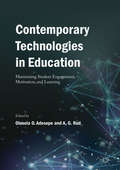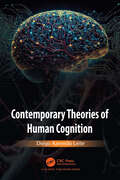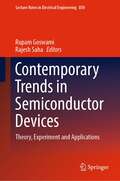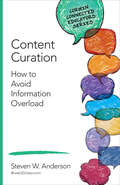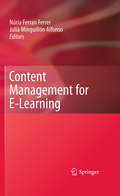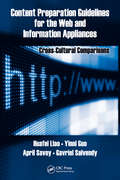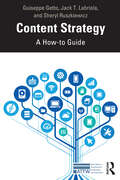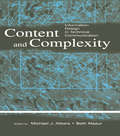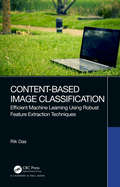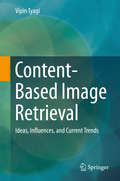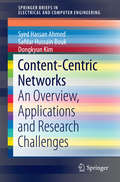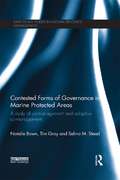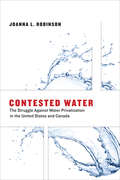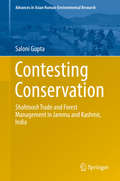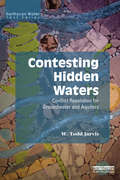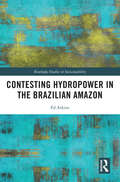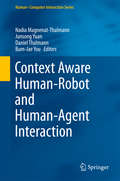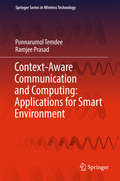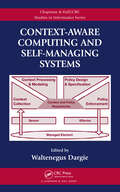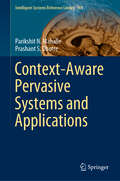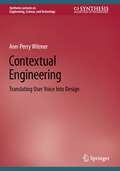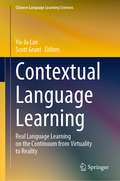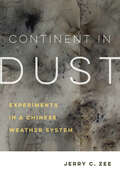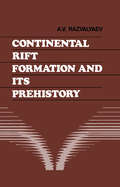- Table View
- List View
Contemporary Technologies in Education: Maximizing Student Engagement, Motivation, and Learning
by A. G. Rud Olusola O. AdesopeThis edited volume provides a critical discussion of theoretical, methodological, and practical developments of contemporary forms of educational technologies. Specifically, the book discusses the use of contemporary technologies such as the Flipped Classroom (FC), Massive Open Online Course (MOOC), Social Media, Serious Educational Games (SEG), Wikis, innovative learning software tools, and learning analytic approach for making sense of big data. While some of these contemporary educational technologies have been touted as panaceas, researchers and developers have been faced with enormous challenges in enhancing the use of these technologies to arouse student attention and improve persistent motivation, engagement, and learning. Hence, the book examines how contemporary technologies can engender student motivation and result in improved engagement and learning. Each chapter also discusses the road ahead and where appropriate, uses the current trend to predict future affordances of technologies.
Contemporary Theories of Human Cognition
by Diego Azevedo LeiteThis book provides a systematic presentation of some of the most relevant contemporary major theories of human cognition. Each theory is analyzed in terms of their origins, central idea, central theoretical elements, empirical evidence and major criticism. This analysis shows the advantages and disadvantages in each theoretical system, thus providing reasonable means for evaluating and comparing these proposals. The discussions are often supported by empirical research, mainly from fields such as cognitive science, cognitive neuroscience and artificial intelligence, and they are combined with rigorous theoretical and argument analysis. The content, therefore, can be helpful for many contemporary central debates concerning the topic of human cognition.
Contemporary Trends in Semiconductor Devices: Theory, Experiment and Applications (Lecture Notes in Electrical Engineering #850)
by Rupam Goswami Rajesh SahaThis book covers evolution, concept and applications of modern semiconductor devices such as tunnel field effect transistors (TFETs), vertical super-thin body MOSFETs, ion sensing FETs (ISFETs), non-conventional solar cells, opto-electro mechanical devices and thin film transistors (TFTs). Comprising of theory, experimentation and applications of devices, the chapters describe state-of-art methods and techniques which shall be highly assistive in having an overall perspective on emerging technologies and working on a research area. The book is aimed at the scholars, enthusiasts and researchers who are currently working on devices in the contemporary era of semiconductor devices. Additionally, the chapters are lucid and descriptive and carry the potential of serving as a reference book for scholars in their undergraduate studies, who are looking ahead for a prospective career in semiconductor devices.
Content Curation: How to Avoid Information Overload (Corwin Connected Educators Series)
by Steven W. AndersonSavvy internet consumption starts right here! Teachers and students are constantly inundated with information, yet lack the organizational skill necessary to effectively utilize it. From Twitter hashtags to online communities, this handy guide will help you to find, store, and share the best information and resources found on the web today—and teach your students to do the same. Real-world tips, tools, in-depth examples and lesson plans help you systematically: Understand the curation process Find, collect, and share reliable web-based information Build students’ information literacy skills Help students research and organize problem-based learning projects Use cutting-edge curation tools like Evernote, Diigo, and Pocket The Corwin Connected Educators series is your key to unlocking the greatest resource available to all educators: other educators. Being a Connected Educator is more than a set of actions: it’s a belief in the potential of technology to fuel lifelong learning. "Speaking from his own experience and perspectives as a learner, teacher, and educational leader, Steven Anderson brings clarity to a process that can be difficult and overwhelming. Steven offers tried and tested strategies and tools for evaluating, organizing, and sharing the vast amount of online content educators and students have at their fingertips. If you′re drowning in digital content, this book is your life jacket. " —Jayme Linton, Assistant Professor of Education Lenoir-Rhyne University, Hickory, NC
Content Curation: How to Avoid Information Overload (Corwin Connected Educators Series)
by Steven W. AndersonSavvy internet consumption starts right here! Teachers and students are constantly inundated with information, yet lack the organizational skill necessary to effectively utilize it. From Twitter hashtags to online communities, this handy guide will help you to find, store, and share the best information and resources found on the web today—and teach your students to do the same. Real-world tips, tools, in-depth examples and lesson plans help you systematically: Understand the curation process Find, collect, and share reliable web-based information Build students’ information literacy skills Help students research and organize problem-based learning projects Use cutting-edge curation tools like Evernote, Diigo, and Pocket The Corwin Connected Educators series is your key to unlocking the greatest resource available to all educators: other educators. Being a Connected Educator is more than a set of actions: it’s a belief in the potential of technology to fuel lifelong learning. "Speaking from his own experience and perspectives as a learner, teacher, and educational leader, Steven Anderson brings clarity to a process that can be difficult and overwhelming. Steven offers tried and tested strategies and tools for evaluating, organizing, and sharing the vast amount of online content educators and students have at their fingertips. If you′re drowning in digital content, this book is your life jacket. " —Jayme Linton, Assistant Professor of Education Lenoir-Rhyne University, Hickory, NC
Content Management for E-Learning
by Julià Minguillón Alfonso Núria Ferran FerrerThe increasing growth in the use of e-learning environments, in which education is delivered and supported through information and communication technologies, has brought new challenges to academic institutions. From all the current definitions of e-learning, it can be seen that learning contents are one of the key issues for a successful e-learning experience. Therefore, there is a real need for academic staff, managers and librarians to re-think the whole process of delivering courses, information resources and information services. The book focuses on defining content management and its relationship with knowledge management, providing perspectives on how the semantic web could complement content management, how to deal with copyright restrictions, and how to describe information competencies and skills required and acquired by teachers and students in virtual environments. Offered is a design project for managing digital content for classical and distance education institutions, covering all the aspects related to the content lifecycle, integrating it into the learning process. Practical aspects such as standards for content e-learning management, a review of existing experiences of learning repositories, and a survey of available platforms for delivering courses and providing access to information resources is also covered. Lastly, the book addresses the three main factors which make it crucial in the current context: first, the web 2.0 paradigm, which breaks the content producer-consumer barrier; second, the open content movement for educational purposes, which changes the knowledge management transference model; and third, the new European Higher Education Area, where the concept of content needs to be rethought.
Content Preparation Guidelines for the Web and Information Appliances: Cross-Cultural Comparisons (Human Factors and Ergonomics)
by Gavriel Salvendy Huafei Liao Yinni Guo April SavoyContent preparation is an integral part of the usability equation: it answers the question of what information is needed for effective decision making. Once content preparation has been established, the question "how to present what" can be answered. Content Preparation Guidelines for the Web and Information Appliances: Cross-Cultural Comparisons p
Content Strategy: A How-to Guide (ATTW Series in Technical and Professional Communication)
by Guiseppe Getto Jack T. Labriola Sheryl RuszkiewiczThis comprehensive text provides a how-to guide for content strategy, enabling students and professionals to understand and master the skills needed to develop and manage technical content in a range of professional contexts. The landscape of technical communication has been revolutionized by emerging technologies such as content management systems, open-source information architecture, and application programming interfaces that change the ways professionals create, edit, manage, and deliver content. This textbook helps students and professionals develop relevant skills for this changing marketplace. It takes readers through essential skills including audience analysis; content auditing; assembling content strategy plans; collaborating with other content developers; identifying appropriate channels of communication; and designing, delivering, and maintaining genres appropriate to those channels. It contains knowledge and best practices gleaned from decades of research and practice in content strategy and provides its audience with a thorough introductory text in this essential area. Content Strategy works as a core or supplemental textbook for undergraduate and graduate classes, as well as certification courses, in content strategy, content management, and technical communication. It also provides an accessible introduction for professionals looking to develop their skills and knowledge.
Content and Complexity: information Design in Technical Communication
by Michael J. Albers Beth MazurInformation design is an emerging area in technical communication, garnering increased attention in recent times as more information is presented through both old and new media. In this volume, editors Michael J. Albers and Beth Mazur bring together scholars and practitioners to explore the issues facing those in this exciting new field. Treating information as it applies to technical communication, with a special emphasis on computer-centric industries, this volume delves into the role of information design in assisting with concepts, such as usability, documenting procedures, and designing for users. Influential members in the technical communication field examine such issues as the application of information design in structuring technical material; innovative ways of integrating information design within development methodologies and social aspects of the workplace; and theoretical approaches that include a practical application of information design, emphasizing the intersection of information design theories and workplace reality. This collection approaches information design from the language-based technical communication side, emphasizing the role of content as it relates to complexity in information design. As such, it treats as paramount the rhetorical and contextual strategies required for the effective design and transmission of information. Content and Complexity: Information Design in Technical Communication explores both theoretical perspectives, as well as the practicalities of information design in areas relevant to technical communicators. This integration of theoretical and applied components make it a practical resource for students, educators, academic researchers, and practitioners in the technical communication and information design fields.
Content-Based Image Classification: Efficient Machine Learning Using Robust Feature Extraction Techniques
by Rik DasContent-Based Image Classification: Efficient Machine Learning Using Robust Feature Extraction Techniques is a comprehensive guide to research with invaluable image data. Social Science Research Network has revealed that 65% of people are visual learners. Research data provided by Hyerle (2000) has clearly shown 90% of information in the human brain is visual. Thus, it is no wonder that visual information processing in the brain is 60,000 times faster than text-based information (3M Corporation, 2001). Recently, we have witnessed a significant surge in conversing with images due to the popularity of social networking platforms. The other reason for embracing usage of image data is the mass availability of high-resolution cellphone cameras. Wide usage of image data in diversified application areas including medical science, media, sports, remote sensing, and so on, has spurred the need for further research in optimizing archival, maintenance, and retrieval of appropriate image content to leverage data-driven decision-making. This book demonstrates several techniques of image processing to represent image data in a desired format for information identification. It discusses the application of machine learning and deep learning for identifying and categorizing appropriate image data helpful in designing automated decision support systems. The book offers comprehensive coverage of the most essential topics, including: Image feature extraction with novel handcrafted techniques (traditional feature extraction) Image feature extraction with automated techniques (representation learning with CNNs) Significance of fusion-based approaches in enhancing classification accuracy MATLAB® codes for implementing the techniques Use of the Open Access data mining tool WEKA for multiple tasks The book is intended for budding researchers, technocrats, engineering students, and machine learning/deep learning enthusiasts who are willing to start their computer vision journey with content-based image recognition. The readers will get a clear picture of the essentials for transforming the image data into valuable means for insight generation. Readers will learn coding techniques necessary to propose novel mechanisms and disruptive approaches. The WEKA guide provided is beneficial for those uncomfortable coding for machine learning algorithms. The WEKA tool assists the learner in implementing machine learning algorithms with the click of a button. Thus, this book will be a stepping-stone for your machine learning journey. Please visit the author's website for any further guidance at https://www.rikdas.com/
Content-Based Image Retrieval: Ideas, Influences, and Current Trends
by Vipin TyagiThe book describes several techniques used to bridge the semantic gap and reflects on recent advancements in content-based image retrieval (CBIR). It presents insights into and the theoretical foundation of various essential concepts related to image searches, together with examples of natural and texture image types. The book discusses key challenges and research topics in the context of image retrieval, and provides descriptions of various image databases used in research studies. The area of image retrieval, and especially content-based image retrieval (CBIR), is a very exciting one, both for research and for commercial applications. The book explains the low-level features that can be extracted from an image (such as color, texture, shape) and several techniques used to successfully bridge the semantic gap in image retrieval, making it a valuable resource for students and researchers interested in the area of CBIR alike.
Content-Centric Networks: An Overview, Applications and Research Challenges (SpringerBriefs in Electrical and Computer Engineering #0)
by Syed Hassan Ahmed Safdar Hussain Bouk Dongkyun KimThis book introduces Content-Centric Networking (CCN), a networking paradigm that provides a simple and effective solution to the challenging demands of future wired and wireless communications. It provides an overview of the recent developments in the area of future internet technologies, bringing together the advancements that have been made in Information-Centric Networking (ICN) in general, with a focus on CCN. It begins with an introduction to the basics of CCN is followed by an overview of the current internet paradigm and its challenges. Next, an application perspective has been included, where the authors encompass the selected applications for CCN with recent refereed research and developments. These applications include Internet of Things (IoT), Smart Grid, Vehicular Ad hoc Networks (VANETs), and Wireless Sensor Networks (WSNs). The book is a useful reference source for practising researchers, and can be used as supporting material for undergraduate and graduate level courses in computer science and electrical engineering.
Contested Forms of Governance in Marine Protected Areas: A Study of Co-Management and Adaptive Co-Management (Earthscan Studies in Natural Resource Management)
by Natalie Bown Tim S. Gray Selina M. SteadIn this book, the authors examine the governance of marine protected areas (MPA), and in particular they compare two different forms of governance – co-management (CM) and adaptive co-management (ACM). CM is characterized by the decentralization of the decision-making process, incorporating the governed as well as the government. ACM is characterized by the dynamic process whereby co-management decision-making is made continuously responsive to the changing ecological and socio-economic circumstances of the MPA. The authors carry out a comprehensive critical analysis of CM and ACM before applying these concepts to the case study of the Cayos Cochinos Marine Protected Area off Honduras to assess two successive management cycles, 2004-9 and 2008-13. The area was designated as an MPA in 1993, a governmental decision which was met with resentment by local communities. CM was introduced in 2004 to involve these local stakeholders in the decision-making process, but achieved limited success. In an attempt to deal with these deficiencies, ACM was adopted in the second management plan in 2008, but whereas the position of the local communities improved, it tipped the scales too far away from conservation. A third management plan is currently being prepared that promises to strike a better balance between ecological and socio-economic objectives. A central theme of the book is to examine how far the CCMPA adhered to the principles of CM and ACM respectively in its first two management plans.
Contested Water: The Struggle Against Water Privatization in the United States and Canada (Urban and Industrial Environments)
by Joanna L. RobinsonAn examination of anti–water privatization movements in the United States and Canada that explores the interplay of the local and the global.Attempts by local governments to privatize water services have met with furious opposition. Activists argue that to give private companies control of the water supply is to turn water from a common resource into a marketized commodity. Moreover, to cede local power to a global corporation puts communities at the center of controversies over economic globalization. In Contested Water, Joanna Robinson examines local social movement organizing against water privatization, looking closely at battles for control of local water services in Stockton, California, and Vancouver, British Columbia. The movements in these two communities had different trajectories, used different tactics, and experienced different outcomes. Robinson analyzes the factors that shaped these two struggles.Drawing on extensive interviews with movement actors, political leaders, and policymakers and detailed analysis of textual material, Robinson shows that the successful campaign in Vancouver drew on tactics, opportunities, and narratives from the broader antiglobalization movement, with activists emphasizing the threats to local democracy and accountability; the less successful movement in Stockton centered on a ballot initiative that was made meaningless by a pre-emptive city council vote. Robinson finds that global forces are reshaping local movements, particularly those that oppose neoliberal reforms at the municipal level. She argues that anti–water privatization movements that link local and international concerns and build wide-ranging coalitions at local and global levels offer an effective way to counter economic globalization. Successful challenges to globalization will not necessarily come from transnational movements but rather from movements that are connected globally but rooted in local communities.
Contesting Conservation
by Saloni GuptaThis book explores today’s changing intellectual climate, wherein understanding politics at different levels from global to local is considered mandatory in order to appraise the outcome of nature conservation interventions. By carefully examining two such processes – the ban on shahtoosh trade and the ‘National Afforestation Programme’ in the Indian state of Jammu and Kashmir, the book reveals how these processes are influenced by politics at different levels – from their introduction at the macro-level to their implementation at the micro-level – and in turn become coloured by the agendas and interests of the various stakeholders involved. Throughout the book, one priority is to give a voice to the poor resource-users who have been traditionally dependent on wildlife and forest resources for mere subsistence. Yet, these same people are who bear the brunt of nature conservation costs, rather than those actors who are responsible for the most serious violations in pursuit of greater profits. Contemporary Environmental Sociology is chiefly characterised by its focus on power relations in resource conservation and management. In ‘political ecology’ literature, too – especially after recognising the paradoxes and limitations of approaches such as ‘sustainable development’, ‘sustainable livelihoods’ and ‘community based natural resource management’ – there is a growing concern for critical analyses of multi-level politics in connection with nature conservation. The purpose of the book is not to challenge the gravity of environmental concerns, but to question the dominance of conservation interests over the subsistence needs of local communities, and to strike a balance between environmental and social justice. It argues that, unless and until more just accountability for the affected populations is ensured, conservation policies are unlikely to meet the goals of sustainable resource management. Given its critical engagement with human-nature conflicts in Jammu and Kashmir, the book offers a unique resource for students and scholars of Environmental Sociology, Political Ecology, Natural Resources Management, Conflict Studies and Human Rights Studies.
Contesting Hidden Waters: Conflict Resolution for Groundwater and Aquifers (Earthscan Water Text)
by W. Todd JarvisThe world increasingly relies on groundwater resources for drinking water and the provision of food for a growing population. The utilization of aquifer systems also extends beyond freshwater supply to include other resources such as heat extraction and the storage and disposal of substances. Unlike other books about conflict resolution and negotiations over water resources, this volume is unique in focusing exclusively on conflicts over groundwater and aquifers. The author explores the specific challenges presented by these "hidden" resources, which are shown to be very different from those posed by surface water resources. Whereas surface watersheds are static, groundwater boundaries are value-laden and constantly changing during development. The book describes the various issues surrounding the governance and management of these resources and the various parties involved in conflicts and negotiations over them. Through first-hand accounts from a pracademic skilled in both process and substance as a groundwater professional and professional mediator, the book offers options for addressing the challenges and issues through a transdisciplinary approach.
Contesting Hydropower in the Brazilian Amazon (Routledge Studies in Sustainability)
by Ed AtkinsIn Contesting Hydropower in the Brazilian Amazon, Ed Atkins focuses on how local, national, and international civil society groups have resisted the Belo Monte and São Luiz do Tapajós hydroelectric projects in Brazil. In doing so, Atkins explores how contemporary opposition to hydropower projects demonstrate a form of ‘contested sustainability’ that highlights the need for sustainable energy transitions to take more into account than merely greenhouse gas emissions. The assertion that society must look to successfully transition away from fossil fuels and towards sustainable energy sources often appears assured in contemporary environmental governance. However, what is less certain is who decides which forms of energy are deemed ‘sustainable.’ Contesting Hydropower in the Brazilian Amazon explores one process in which the sustainability of a ‘green’ energy source is contested. It focuses on how civil society actors have both challenged and reconfigured dominant pro-dam assertions that present the hydropower schemes studied as renewable energy projects that contribute to sustainable development agendas. The volume also examines in detail how anti-dam actors act to render visible the political interests behind a project, whilst at the same time linking the resistance movement to wider questions of contemporary environmental politics. This interdisciplinary work will be of great interest to students and scholars of sustainable development, sustainable energy transitions, environmental justice, environmental governance, and development studies.
Context Aware Human-Robot and Human-Agent Interaction (Human–Computer Interaction Series)
by Daniel Thalmann Nadia Magnenat-Thalmann Junsong Yuan Bum-Jae YouThis is the first book to describe how Autonomous Virtual Humans and Social Robots can interact with real people, be aware of the environment around them, and react to various situations. Researchers from around the world present the main techniques for tracking and analysing humans and their behaviour and contemplate the potential for these virtual humans and robots to replace or stand in for their human counterparts, tackling areas such as awareness and reactions to real world stimuli and using the same modalities as humans do: verbal and body gestures, facial expressions and gaze to aid seamless human- computer interaction (HCI). The research presented in this volume is split into three sections: User Understanding through Multisensory Perception: deals with the analysis and recognition of a given situation or stimuli, addressing issues of facial recognition, body gestures and sound localization. Facial and Body Modelling Animation: presents the methods used in modelling and animating faces and bodies to generate realistic motion. Modelling Human Behaviours: presents the behavioural aspects of virtual humans and social robots when interacting and reacting to real humans and each other. Context Aware Human-Robot and Human-Agent Interaction would be of great use to students, academics and industry specialists in areas like Robotics, HCI, and Computer Graphics.
Context-Aware Communication and Computing: Applications for Smart Environment (Springer Series in Wireless Technology)
by Ramjee Prasad Punnarumol TemdeeThis book introduces context-aware computing, providing definitions, categories, characteristics, and context awareness itself and discussing its applications with a particular focus on smart learning environments. It also examines the elements of a context-aware system, including acquisition, modelling, reasoning, and distribution of context. It also reviews applications of context-aware computing - both past and present - to offer readers the knowledge needed to critically analyse how context awareness can be put to use. It is particularly to those new to the subject area who are interested in learning how to develop context-aware computing-oriented applications, as well as postgraduates and researchers in computer engineering, communications engineering related areas of information technology (IT). Further it provides practical know-how for professionals working in IT support and technology, consultants and business decision-makers and those working in the medical, human, and social sciences.
Context-Aware Computing and Self-Managing Systems
by Waltenegus DargieBringing together an extensively researched area with an emerging research issue, Context-Aware Computing and Self-Managing Systems presents the core contributions of context-aware computing in the development of self-managing systems, including devices, applications, middleware, and networks. The expert contributors reveal the usefulness of contex
Context-Aware Pervasive Systems and Applications (Intelligent Systems Reference Library #169)
by Parikshit N. Mahalle Prashant S. DhotreThis textbook explores the current challenges in and future prospects of context-aware pervasive systems and applications. The phenomenal advances in broadband technology and ubiquitous access to the Internet have transformed Internet computing into the Internet of Things (IoT), which is now evolving toward the Internet of Everything. Modern scientific, engineering, and business applications are increasingly dependent on machine-to-machine communication, wherein there is less human intervention. In turn, this creates a need for context-aware pervasive systems and applications in which RFID, sensors, and smartphones play a key role. The book provides an essential overview of context, context management, and how to perform context management in various use cases. In addition, it addresses context-aware computing and personalization, various architectures for context-aware systems, and security issues. The content is explained using straightforward language and easy-to-follow examples, case studies, technical descriptions, procedures, algorithms, and protocols for context-aware systems.
Contextual Engineering: Translating User Voice Into Design (Synthesis Lectures on Engineering, Science, and Technology)
by Ann-Perry WitmerThis book shows readers a new way of thinking about the engineering design process, as well as how to expand their understanding of the role of technical designers in society, whether working with international communities or user populations from their own hometown. As readers build an understanding of Contextual Engineering, this book will challenge them to think about the applicability of the concept more broadly, not only in terms of technical design but in personal and professional interactions with others as well. At the same time, readers will learn techniques to explore their own predispositions and the biases they may not be aware they have, equipping them to interact with others more impartially. This self-reflection process also assists the designer in working with and accepting the uncertainty that is inherent in exploring context.
Contextual Language Learning: Real Language Learning on the Continuum from Virtuality to Reality (Chinese Language Learning Sciences)
by Yu-Ju Lan Scott GrantThis book presents research and developments in the virtual, augmented technology and mixed-reality used in language learning and teaching. It provides the readers with a comprehensive overview of contextual language learning with the support of immersive technology. From theoretical foundations, methodological issues, the features of virtual and augmented reality, and educational practices of language learning, to the future of immersive technology for and research on language learning. During the past two decades, abundant research on different realities has recognized the potential of language learning in virtual, augmented, and mixed-reality environments (Wang et al., 2020; Lin & Lan, 2015). Given insufficient studies of Chinese learning in immersive contexts reported in existing literature, this book includes several excellent studies about using immersive technologies for Chinese learning in addition to other foreign langue learning, such as English as a foreign language (EFL). Since learning Chinese has grown significantly as a global trend, the authors vitally consolidate and synthesize various theoretical foundations, visions, and recent research and practices in the context of Chinese teaching from broader and more diverse perspectives. On the other hand, the chapters about EFL learning also shed light on the research on contextual language learning. Thus, the chapters included in this book will likely provide readers with a deep and extensive understanding of the potential of the smart combination of immersive technologies and language learning. More issues for future research will undoubtedly be inspired by reading the chapters in this book.
Continent in Dust: Experiments in a Chinese Weather System (Critical Environments: Nature, Science, and Politics #10)
by Jerry C. ZeeIn China, the weather has changed. Decades of reform have been shadowed by a changing meteorological normal: seasonal dust storms and spectacular episodes of air pollution have reworked physical and political relations between land and air in China and downwind. Continent in Dust offers an anthropology of strange weather, focusing on intersections among statecraft, landscape, atmosphere, and society. Traveling from state engineering programs that attempt to choreograph the movement of mobile dunes in the interior, to newly reconfigured bodies and airspaces in Beijing, and beyond, this book explores contemporary China as a weather system in the making: what would it mean to understand "the rise of China" literally, as the country itself rises into the air?
Continental Rift Formation and its Prehistory
by A.V. RazvalyaevTranslation of the Russian edition of 1988 on peculiarities of the Arabian-Nubian Shield in the Precambrian, prerift magmatism in the Red Sea Rift zone, evolution of the crust in rift forming zones.
